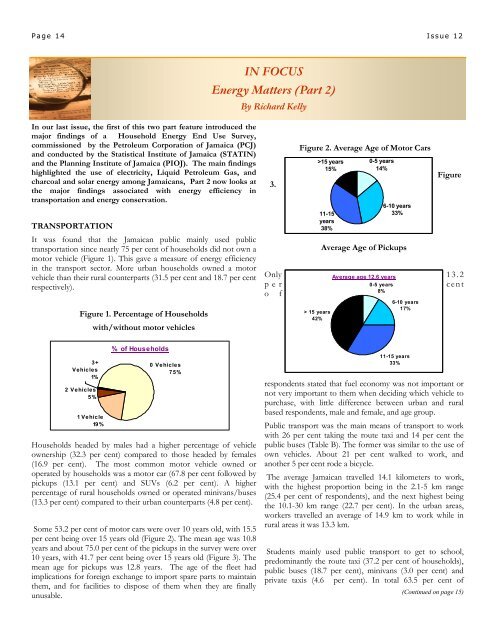Beginnings Issue 12.pub - Planning Institute of Jamaica
Beginnings Issue 12.pub - Planning Institute of Jamaica
Beginnings Issue 12.pub - Planning Institute of Jamaica
Create successful ePaper yourself
Turn your PDF publications into a flip-book with our unique Google optimized e-Paper software.
P a ge 14 I s s u e 12<br />
IN FOCUS<br />
Energy Matters (Part 2)<br />
By Richard Kelly<br />
In our last issue, the first <strong>of</strong> this two part feature introduced the<br />
major findings <strong>of</strong> a Household Energy End Use Survey,<br />
commissioned by the Petroleum Corporation <strong>of</strong> <strong>Jamaica</strong> (PCJ)<br />
and conducted by the Statistical <strong>Institute</strong> <strong>of</strong> <strong>Jamaica</strong> (STATIN)<br />
and the <strong>Planning</strong> <strong>Institute</strong> <strong>of</strong> <strong>Jamaica</strong> (PIOJ). The main findings<br />
highlighted the use <strong>of</strong> electricity, Liquid Petroleum Gas, and<br />
charcoal and solar energy among <strong>Jamaica</strong>ns, Part 2 now looks at<br />
the major findings associated with energy efficiency in<br />
transportation and energy conservation.<br />
TRANSPORTATION<br />
It was found that the <strong>Jamaica</strong>n public mainly used public<br />
transportation since nearly 75 per cent <strong>of</strong> households did not own a<br />
motor vehicle (Figure 1). This gave a measure <strong>of</strong> energy efficiency<br />
in the transport sector. More urban households owned a motor<br />
vehicle than their rural counterparts (31.5 per cent and 18.7 per cent<br />
respectively).<br />
Figure 1. Percentage <strong>of</strong> Households<br />
3+<br />
Vehicles<br />
1%<br />
2 Vehicles<br />
5%<br />
1 Vehicle<br />
19%<br />
with/without motor vehicles<br />
% <strong>of</strong> Households<br />
0 Vehicles<br />
75%<br />
Households headed by males had a higher percentage <strong>of</strong> vehicle<br />
ownership (32.3 per cent) compared to those headed by females<br />
(16.9 per cent). The most common motor vehicle owned or<br />
operated by households was a motor car (67.8 per cent followed by<br />
pickups (13.1 per cent) and SUVs (6.2 per cent). A higher<br />
percentage <strong>of</strong> rural households owned or operated minivans/buses<br />
(13.3 per cent) compared to their urban counterparts (4.8 per cent).<br />
Some 53.2 per cent <strong>of</strong> motor cars were over 10 years old, with 15.5<br />
per cent being over 15 years old (Figure 2). The mean age was 10.8<br />
years and about 75.0 per cent <strong>of</strong> the pickups in the survey were over<br />
10 years, with 41.7 per cent being over 15 years old (Figure 3). The<br />
mean age for pickups was 12.8 years. The age <strong>of</strong> the fleet had<br />
implications for foreign exchange to import spare parts to maintain<br />
them, and for facilities to dispose <strong>of</strong> them when they are finally<br />
unusable.<br />
3.<br />
Figure 2. Average Age <strong>of</strong> Motor Cars<br />
11-15<br />
years<br />
38%<br />
Average Age <strong>of</strong> Pickups<br />
Figure<br />
Only Average age 12.6 years<br />
1 3 . 2<br />
p e r<br />
0-5 years<br />
c e n t<br />
8%<br />
o f<br />
> 15 years<br />
42%<br />
>15 years<br />
15%<br />
0-5 years<br />
14%<br />
6-10 years<br />
33%<br />
6-10 years<br />
17%<br />
11-15 years<br />
33%<br />
respondents stated that fuel economy was not important or<br />
not very important to them when deciding which vehicle to<br />
purchase, with little difference between urban and rural<br />
based respondents, male and female, and age group.<br />
Public transport was the main means <strong>of</strong> transport to work<br />
with 26 per cent taking the route taxi and 14 per cent the<br />
public buses (Table B). The former was similar to the use <strong>of</strong><br />
own vehicles. About 21 per cent walked to work, and<br />
another 5 per cent rode a bicycle.<br />
The average <strong>Jamaica</strong>n travelled 14.1 kilometers to work,<br />
with the highest proportion being in the 2.1-5 km range<br />
(25.4 per cent <strong>of</strong> respondents), and the next highest being<br />
the 10.1-30 km range (22.7 per cent). In the urban areas,<br />
workers travelled an average <strong>of</strong> 14.9 km to work while in<br />
rural areas it was 13.3 km.<br />
Students mainly used public transport to get to school,<br />
predominantly the route taxi (37.2 per cent <strong>of</strong> households),<br />
public buses (18.7 per cent), minivans (3.0 per cent) and<br />
private taxis (4.6 per cent). In total 63.5 per cent <strong>of</strong><br />
(Continued on page 15)
















